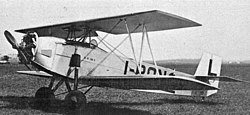Avia BH-29
| Avia BH-29 | |
|---|---|

|
|
| Type: | Trainer aircraft |
| Design country: | |
| Manufacturer: | |
| First flight: |
1927 |
The Avia BH-29 is a Czechoslovak biplane trainer from 1927. The aircraft was designed by Pavel Beneš and Miroslav Hajn.
construction
The Czechoslovak Air Force and the airline ČLS needed a beginner training aircraft . Accordingly, Beneš and Hajn designed the single-handled double-decker with an uneven span. The BH-29 was a wooden construction with a plywood coating for the fuselage and a fabric covering for the remaining surfaces. As a beginner training aircraft, it had a robust, broad-gauge chassis. The flight instructor and student sat in an open tandem cockpit.
Only a few copies were built, although the flight captain Hamšk made a promotional trip through 18 European countries with one of the two prototypes.
Technical specifications
| Parameter | Data |
|---|---|
| crew | 2 (1 flight instructor, 1 student) |
| span | 9.80 m |
| length | 7.40 m |
| Wing area | 25 m² |
| Wing loading | 29 kg / m² |
| Empty mass | 830 kg |
| Takeoff mass | 1090 kg |
| Engine | a Walter NZ 120 radial engine |
| power | 89 kW (approx. 120 PS) |
| Top speed | 145 km / h |
| Cruising speed | 105 km / h |
| Rate of climb | 2.5 m / s |
| Service ceiling | 4000 m |
| Range | 600 km |
literature
- Michael JH Taylor: Jane's Encyclopedia of Aviation. Studio Editions, London 1989, p. 86.
- Václav Němeček: Československá letadla. Naše Vojsko, Prague 1968
Web links
Commons : Avia BH-29 - Collection of images, videos and audio files
